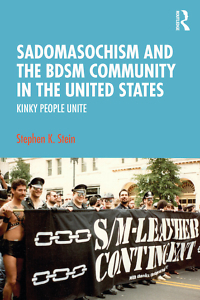Spanks for the Memories
Stephen K. Stein discusses the BDSM movement in modern America
Susan Sontag once called BDSM “the furthest reach of the sexual experience.” As historian Stephen K. Stein shows in his new book, Sadomasochism and the BDSM Community in the United States, the sexual community of BDSM (Bondage and Discipline, Dominance and Submission, and Sadism and Masochism) has evolved over the past half-century. Its practitioners have shifted their practices and gained more mainstream acceptance, fostering a broader culture of sexual freedom in the modern United States.
 Stein is an associate professor of history at the University of Memphis. He is the author of From Torpedoes to Aviation: Washington Irving Chambers and Technological Innovation in the New Navy, 1877-1913, among other publications, and he is the editor of The Sea in World History: Trade, Travel, and Exploration. He answered questions via email from Chapter 16:
Stein is an associate professor of history at the University of Memphis. He is the author of From Torpedoes to Aviation: Washington Irving Chambers and Technological Innovation in the New Navy, 1877-1913, among other publications, and he is the editor of The Sea in World History: Trade, Travel, and Exploration. He answered questions via email from Chapter 16:
Chapter 16: What is BDSM? How can a historian research it?
Stephen K. Stein: The term BDSM, a condensed abbreviation of bondage and discipline (B&D), dominance and submission (D&S), and sadism and masochism (S&M), became popular in the mid-1990s. It combined the most commonly used terms for these activities and settled arguments among BDSM practitioners over what to label what they did, avoiding the term sadomasochism, which many saw as pejorative. Generally speaking, BDSM includes a host of practices that inject a power dynamic into sexual activities, though many people engage in BDSM activities, such as flagellation, that do not specifically lead to sexual intercourse.
The BDSM community offers rich opportunities for historians. The Leather Archives and Museum in Chicago is dedicated to preserving the community’s history, along with that of leather organizations, whose membership often overlaps that of BDSM organizations. It has the papers of many important BDSM activists, as well as club newsletters, convention programs, and other publications. Most of these, though, date from 1980 to the present.
The BDSM community’s earlier years are very poorly documented. The Kinsey Archive has some records from the 1950s and 1960s, mostly pertaining to BDSM businesses and publishers. Several archives with extensive LGBTQ+ holdings, such as the GLBT Historical Society in San Francisco, also house collections important to researching BDSM since these communities overlap. While many of the BDSM community’s early organizers and activists have died over the last 20 years, others remain active, offering opportunities to oral historians.
Chapter 16: Your career has followed a fascinating arc. You’re trained as a military and diplomatic historian, and you are the author of a respected monograph on naval warfare. How did you turn to researching and writing about the BDSM community?
Stein Early in my career, I did some work for one of the big textbook publishers. The editor I worked with was an important member of the National Leather Association (NLA), the largest American BDSM organization in the 1990s. Many years later, she approached me to write the NLA’s history, Living in Leather, which was published in 2012. I built on that work to complete Sadomasochism and the BDSM Community in the United States. It’s a rare opportunity to write the first history of a community, so I jumped at the chance.
One of the professors I worked with for my B.A. and M.A., Mark Foster at the University of Colorado, changed his area or specialty every 7 to 10 years, moving from political to urban to business and eventually African American history. While I do not aspire to such breadth, I don’t want to be one of those scholars who relentlessly plows the same overworked field. There is great value in reaching beyond one’s core expertise. And perhaps military history and BDSM are not that far apart. Both involve violence and power. The difference, of course, is that one is deadly serious and the other a path to pleasure.
 Chapter 16: How has the status of BDSM evolved in the United States since the 1960s? Have the sexual practices changed over this time? How were BDSM communities built?
Chapter 16: How has the status of BDSM evolved in the United States since the 1960s? Have the sexual practices changed over this time? How were BDSM communities built?
Stein: Popular, psychological, and legal perceptions of BDSM have changed dramatically over the last 50 years. Previously seen as a mental dysfunction subject to criminal prosecution and requiring psychiatric treatment, BDSM activities today spark much less disapprobation.
Today’s BDSM community evolved slowly over time as people with BDSM interests found one another via personal ads, cruising bars and bathhouses, and personal introductions. The first formal, publicly advertised BDSM organizations formed in the early 1970s as forums for learning, personal exploration, and finding like-minded partners.
BDSM organizations exploded in size and number in the 1980s, and these organizations helped institutionalize and normalize BDSM practice, encouraging some activities and discouraging others. Practically every American city has a local BDSM group (or several), and these remain the central institutions of the community despite the growth of FetLife and other Internet sites, which connect kinky people.
Chapter 16: Why did BDSM leaders advocate a “safe, sane, and consensual” movement in the 1980s and 1990s? Did this make BDSM more “respectable”?
Stein: Early BDSM organizations and activists struggled to define and explain their sexual interests. In the mid-1980s, they adopted the phrase “safe, sane, consensual.” It proved useful against both external critics (“What we do is safe, sane, and consensual, so leave us alone”) and to police conduct within the BDSM community (“What you’re doing is not safe, sane, consensual, so knock it off”). Over time, the community’s emphasis on consent and the individual right to pursue happiness in one’s own way proved an effective counterargument to BDSM critics.
Chapter 16: What is the historical relationship between BDSM and LGBTQ communities? Did they work more in concert or opposition?
Stein: Many — arguably most — of the early BDSM activists were gay or lesbian or bisexual or influenced by the LGBTQ community. Gay leather bars, which emerged in the 1950s, proved one of the most reliable places to meet men with BDSM interests. When dedicated BDSM organizations formed in the 1970s and 1980s, many were exclusively gay or lesbian. The leaders of these organizations played a central role in organizing the BDSM community, and the BDSM community reflects their values. Across the United States, BDSM organizations worked to advance LGBTQ rights, and sexual rights, in general.
Leaders of LGBTQ organizations, though, often regarded BDSM with suspicion. Most LGBTQ political organizations banned open displays of leather and/or BDSM paraphernalia and prohibited participation by BDSM organizations in pride marches and similar events. That changed in the mid-1980s. The 1987 and 1993 marches on Washington and the 1994 commemoration of the 25th anniversary of Stonewall in New York all featured large BDSM/leather contingents because LGBTQ leaders recognized the value of building the largest possible coalition. They came to value BDSM and leather organizations for their fundraising and ability to mobilize large contingents for parades and demonstrations.
In the 1990s, the largest and most important LGBTQ organizations increasingly welcomed leather and BDSM organizations. One of them even created an annual award for leather activism. Yet today there is new talk of banning leather and BDSM folks from pride events. While most LGBTQ activists do not appear to have a problem with BDSM activities per se, they prefer that BDSM/leather people keep their activities entirely private. They worry opponents of LGBTQ rights will use visible displays of BDSM to demonize the entire LGBTQ community. So the issue remains unsettled.
Chapter 16: Fifty Shades of Grey was a blockbuster, both as the 2011 novel and 2015 film. How was this phenomenon received within BDSM circles?
Stein: Fifty Shades of Grey has been a mixed blessing for the BDSM community. It reversed the membership declines of many BDSM organizations by attracting new people to the community. This growing BDSM interest also caught the attention of sexually oriented businesses, which expanded their product lines to include restraints and other BDSM equipment. There is easier access to a greater variety of low-cost BDSM paraphernalia than ever before.
On the other hand, most members of the BDSM community were offended — even outraged — by the depictions of BDSM in Fifty Shades, particularly how the relationship developed between Anastasia Steele and Christian Grey, which involved manipulation and coercion rather than negotiation. It generally ignored the community’s credo of “safe, sane, consensual.” Many commentators — not just those with BDSM experience — found the book’s depictions of Steele’s sexual awakening and first BDSM experiences unrealistic.
The book (and film) also repeat the common trope that people drawn to BDSM were abused as children or experienced other psychological trauma, which they reenact in BDSM scenes. Numerous psychological surveys of the community, though, have found no evidence to support this. Apart from their sexual interests, people into BDSM differ little from their vanilla friends. They are a fairly representative cross-section of their societies.
The Fifty Shades controversy is hardly new. BDSM activists have long complained about negative portrayals of BDSM in film and television, particularly crime shows like Law & Order. Until recently, producers ignored these complaints. Recently, though, Netflix responded to complaints by BDSM practitioners about its new show Bonding. Its producers have engaged with the community, hired informed consultants from the community, and have promised to do better in the show’s next season. This, too, may reflect society’s greater acceptance of BDSM activities.

Aram Goudsouzian is the Bizot Family Professor of History at the University of Memphis. His most recent book is The Men and the Moment: The Election of 1968 and the Rise of Partisan Politics in America.





